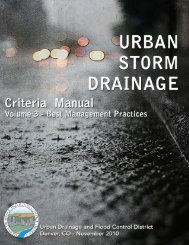Physical Modeling of Median Inlets
Physical Modeling of Median Inlets
Physical Modeling of Median Inlets
You also want an ePaper? Increase the reach of your titles
YUMPU automatically turns print PDFs into web optimized ePapers that Google loves.
<strong>Inlets</strong> - Type 13 and Type 16 (van grate )<br />
2012 Annual UCFCD Conference<br />
2
Combination <strong>Inlets</strong><br />
ONE and TWO grates<br />
2012 Annual UCFCD Conference<br />
3
Inlet Type – R<br />
5 and 10 ft.<br />
2012 Annual UCFCD Conference<br />
4
Type C and D <strong>Inlets</strong><br />
Type C = 3‐ft by 3‐ft Grate<br />
Type D=3‐ft by 6‐ft Grate<br />
2012 Annual UCFCD Conference<br />
5
CURRENT CDOT DEISGN PRACTICE<br />
for Type C and Type D <strong>Inlets</strong><br />
Two Type C ‘s = 1.8 x Single Type C<br />
Three Type C’s = 2.5 x Single Type C<br />
Speculated based on Orifice Flow<br />
2012 Annual UCFCD Conference<br />
6
In a Sump<br />
Hydraulics<br />
Flat Type C<br />
Cw=?<br />
Co=?<br />
2012 Annual UCFCD Conference<br />
7
Type C on a Grade with an Inclined Angle<br />
On a Grade<br />
2012 Annual UCFCD Conference<br />
8
Type D Model <strong>Inlets</strong> laid in Series<br />
Flow Direction<br />
2012 Annual UCFCD Conference<br />
9
Type D Model <strong>Inlets</strong> laid in Parallel (Rotated)<br />
Flow Direction<br />
2012 Annual UCFCD Conference<br />
10
Setup in the Hydraulic Laboratory<br />
2012 Annual UCFCD Conference<br />
11
How to Collect Flow Data<br />
Working<br />
With Hands‐in<br />
Fishing<br />
With Hands‐out<br />
2012 Annual UCFCD Conference<br />
12
Summary <strong>of</strong> Data Collections<br />
Model Scale = 1/3 using Froude Number Similarity<br />
Matrix <strong>of</strong> Inlet Parameters<br />
<strong>Inlets</strong> = Type C or Type D<br />
Depression Depth = 0 or 1 foot.<br />
Inclined angles= 0, 10, 20, and 30 degrees<br />
Orientation = In-series or In-parallel (Rotated)<br />
A total <strong>of</strong> 96 data sets was collected, and each data set includes:<br />
(1) flow intercepted by the model inlet and<br />
(2) flow depth at the front <strong>of</strong> the model inlet.<br />
Flow Depth Discharge Intercepted<br />
Min Max Min Max<br />
feet feet cfs cfs<br />
Model 0.32 1.38 1.11 17.29<br />
Prototye 0.96 4.14 7.93 123.55<br />
2012 Annual UCFCD Conference<br />
13
Theoretical Capacity –<br />
Type C = Inclined Outlet Box for Detention<br />
When water depth Ht (un‐submerged)<br />
Qsw = weir flow on two submerged sides<br />
Qbw = weir flow on the submerged base width<br />
Qo = orifice flow for the submerged area<br />
Design Q = min (2Qsw+Qbw, Qo)<br />
2012 Annual UCFCD Conference<br />
14
2012 Annual UCFCD Conference<br />
15
Data Analysis –Type C inlet –Flat W/O Depression<br />
2012 Annual UCFCD Conference<br />
16
Data Analysis – Type C inlet – Flat W 1-ft Depression<br />
2012 Annual UCFCD Conference<br />
17
Flow Coefficients for Type C Inlet<br />
W and W/O One-ft Depression<br />
1.20<br />
1.00<br />
Type C Inlet<br />
Flow Coeff Cd<br />
0.80<br />
0.60<br />
0.40<br />
0.20<br />
0.00<br />
0.00 10.00 20.00 30.00 40.00<br />
C‐flat C‐depressed<br />
Inclined Angle (degrees)<br />
2012 Annual UCFCD Conference<br />
18
Data Analysis – Type D inlet with Various Inclined Angles<br />
2012 Annual UCFCD Conference<br />
19
Data Analysis – Type D inlet – 1-ft Depression<br />
2012 Annual UCFCD Conference<br />
20
Flow Coefficients for Type D Inlet<br />
W and W/O One-ft Depression<br />
Flow Coeff Cd<br />
Type D Inlet<br />
0.90<br />
0.80<br />
0.70<br />
0.60<br />
0.50<br />
0.40<br />
0.30<br />
0.20<br />
0.10<br />
0.00<br />
0.00 10.00 20.00 30.00 40.00<br />
D‐flat<br />
D‐depressed<br />
Inclined Angle (degrees)<br />
2012 Annual UCFCD Conference<br />
21
Flow Coefficients for Type D Rotated Inlet<br />
W and W/O One‐ft Depression<br />
Type D Inlet‐Rotated<br />
Flow Coeff Cd<br />
0.80<br />
0.70<br />
0.60<br />
0.50<br />
0.40<br />
0.30<br />
0.20<br />
0.10<br />
0.00<br />
0.00 10.00 20.00 30.00 40.00<br />
D‐rot‐flat<br />
D‐rot‐depressed<br />
Inclined Angle (degrees)<br />
2012 Annual UCFCD Conference<br />
22
Comparison with current practice<br />
Single Double Triple Ratio Ratio<br />
Type C Type C Type C 2 to 1 3 to 1<br />
cfs cfs cfs<br />
13.10 18.56 24.02 1.42 1.83<br />
32.43 52.50 67.94 1.62 2.10<br />
45.86 91.71 137.57 2.00 3.00<br />
56.16 112.33 168.49 2.00 3.00<br />
2012 Annual UCFCD Conference<br />
23
Debris Clogging ‐‐<br />
Effective Orifice Area and Wetted Weir Length<br />
2012 Annual UCFCD Conference 24
From Theory to Practice<br />
2012 Annual UCFCD Conference<br />
25
Flood during construction<br />
2012 Annual UCFCD Conference<br />
26
Flood due to clogged drain<br />
OVERLOADED SEDIEMNT FROM CONSTRUCTION SITE<br />
2012 Annual UCFCD Conference<br />
27
Damage due to Bridge Deck Drains<br />
2012 Annual UCFCD Conference<br />
28
Erosion due to Bridge Deck Drains<br />
2012 Annual UCFCD Conference<br />
29
Project Sponsors: UDFCD+CDOT and Others<br />
Model Design:<br />
Ken MacKenzie, UDFCD<br />
Data Collection:<br />
Brendan C. Comport, Amanda L. Cox,<br />
CSU Hydraulic Laboratory<br />
Theory & Data Analysis: James C.Y. Guo, UC‐Denver<br />
Project Reviewer: Amanullah Mommandi, CDOT<br />
Field Work<br />
2012 Annual UCFCD Conference<br />
30

















